归化与异化翻译实例
- 格式:doc
- 大小:34.50 KB
- 文档页数:2

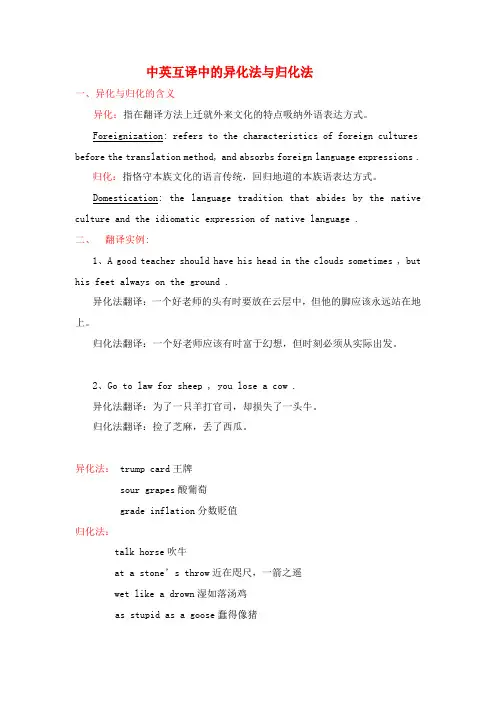
中英互译中的异化法与归化法一、异化与归化的含义异化:指在翻译方法上迁就外来文化的特点吸纳外语表达方式。
Foreignization: refers to the characteristics of foreign cultures before the translation method, and absorbs foreign language expressions .归化:指恪守本族文化的语言传统,回归地道的本族语表达方式。
Domestication: the language tradition that abides by the native culture and the idiomatic expression of native language .二、翻译实例:1、A good teacher should have his head in the clouds sometimes , but his feet always on the ground .异化法翻译:一个好老师的头有时要放在云层中,但他的脚应该永远站在地上。
归化法翻译:一个好老师应该有时富于幻想,但时刻必须从实际出发。
2、Go to law for sheep , you lose a cow .异化法翻译:为了一只羊打官司,却损失了一头牛。
归化法翻译:捡了芝麻,丢了西瓜。
异化法: trump card王牌sour grapes酸葡萄grade inflation分数贬值归化法:talk horse吹牛at a stone’s throw近在咫尺,一箭之遥wet like a drown湿如落汤鸡as stupid as a goose蠢得像猪A big reward will make the brave come forward. 重赏之下,必有勇夫。
Only a headhunter like Bo Le---an ancient Chinese good at headhunting fine steeds---can discover talented people. 有伯乐而后得千里马。
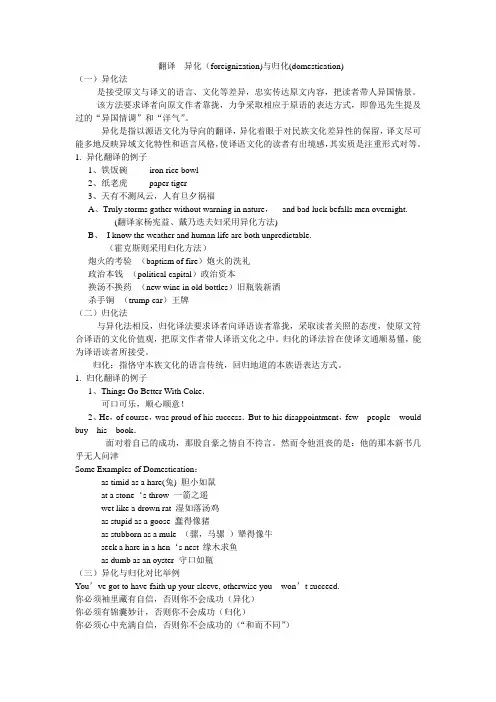
翻译---异化(foreignization)与归化(domestication)(一)异化法是接受原文与译文的语言、文化等差异,忠实传达原文内容,把读者带人异国情景。
该方法要求译者向原文作者靠拢,力争采取相应于原语的表达方式,即鲁迅先生提及过的“异国情调”和“洋气”。
异化是指以源语文化为导向的翻译,异化着眼于对民族文化差异性的保留,译文尽可能多地反映异域文化特性和语言风格,使译语文化的读者有出境感,其实质是注重形式对等。
1. 异化翻译的例子1、铁饭碗iron rice bowl2、纸老虎paper tiger3、天有不测风云,人有旦夕祸福A、Truly storms gather without warning in nature,and bad luck befalls men overnight.(翻译家杨宪益、戴乃迭夫妇采用异化方法)B、I know the weather and human life are both unpredictable.(霍克斯则采用归化方法)炮火的考验--(baptism of fire)炮火的洗礼政治本钱--(political capital)政治资本换汤不换药--(new wine in old bottles)旧瓶装新酒杀手锏--(trump car)王牌(二)归化法与异化法相反,归化译法要求译者向译语读者靠拢,采取读者关照的态度,使原文符合译语的文化价值观,把原文作者带人译语文化之中。
归化的译法旨在使译文通顺易懂,能为译语读者所接受。
归化:指恪守本族文化的语言传统,回归地道的本族语表达方式。
1. 归化翻译的例子1、Things Go Better With Coke.可口可乐,顺心顺意!2、He,of course,was proud of his success.But to his disappointment,few people would buy his book.面对着自已的成功,那股自豪之情自不待言。
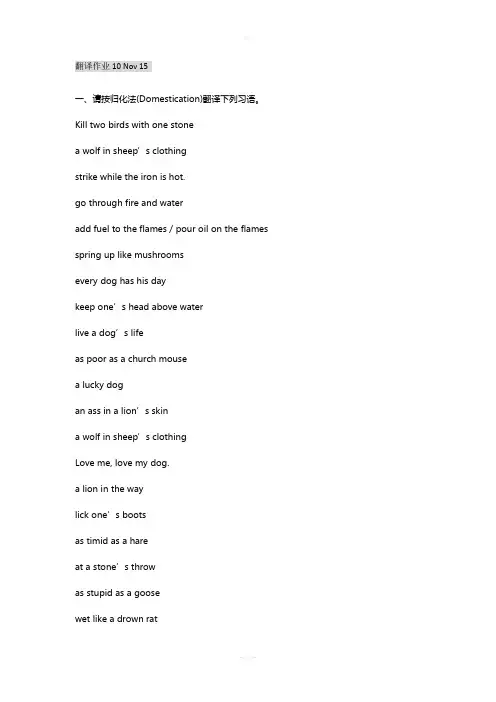
翻译作业10 Nov 15一、请按归化法(Domestication)翻译下列习语。
Kill two birds with one stonea wolf in sheep’s clothingstrike while the iron is hot.go through fire and wateradd fuel to the flames / pour oil on the flames spring up like mushroomsevery dog has his daykeep one’s head above waterlive a dog’s lifeas poor as a church mousea lucky dogan ass in a lion’s skina wolf in sheep’s clothingLove me, love my dog.a lion in the waylick one’s bootsas timid as a hareat a stone’s throwas stupid as a goosewet like a drown ratas dumb as an oysterlead a dog’s lifetalk horseOne boy is a boy, two boys half a boy, and three boys nobody.Man proposes, God disposes.Cry up wine and sell vinegar (cry up, to praise; extol: to cry up one's profession) Once bitten, twice shy.An hour in the morning is worth two in the evening.New booms sweep clean.take French leaveseek a hare in a hen’s nesthave an old head on young shoulderJustice has long armsYou can’t teach an old dogRome was not built in a day.He that lives with cripples learns to limp.Everybody’s business is nobody’s business.The more you get, the more you want.二、请按异化法(foreignization)翻译下列习语。

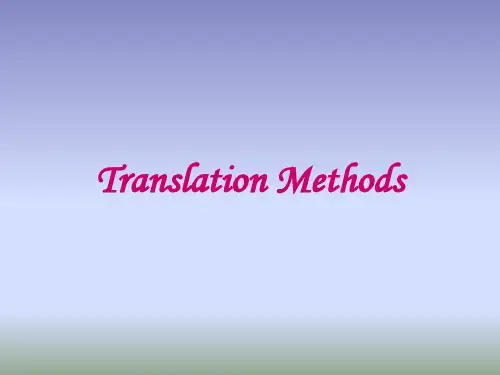
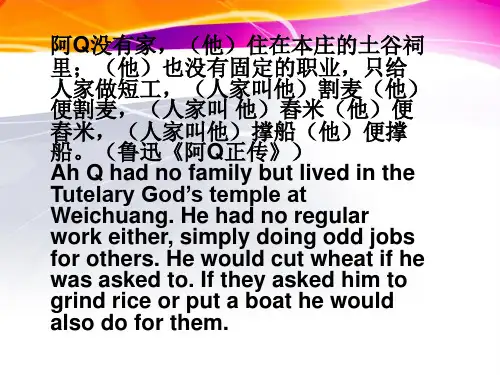

翻译的归化异化例子翻译的归化异化例子【篇一:翻译的归化异化例子】归化和异化翻译中的认识摘要:归化和异化是处理语言形式与文化因素的两种不同的翻译策略,它是意译和直译的进一步延伸,从二者的概念入手,用实例阐述了它们在翻译过程中相辅相成,并用互补的辩证关系。
关键词:归化;异化;概念;辩证关系1 归化、异化区别于意译、直译2 归化、异化的概念归化(domestication)是指在翻译中采用透明、流畅的风格,最大限度地淡化原文的陌生感的翻译策略(shuttleworth&cowie,1997:43-44)。
它应尽可能的使源语文本所反映的世界接近目的语文化读者的世界,从而达到源语文化与目的语文化之间的“文化对等”。
异化(foreignization)是指偏离本土主流价值观,保留原文的语言和文化差异(venuti,2001:240);或指在一定程度上保留原文的异域性,故意打破目标语言常规的翻译(shuttleworth&cowie,1997:59)。
它主张在译文中保留源语文化,丰富目的语文化和目的语的语言表达方式。
用通俗的语言概括,即归化法要求译者向译语读者靠拢,采取译语读者习惯的译语表达方式,来传达原文的内容;异化法则要求译者向作者靠拢,采取相应于作者使用的原语表达方式,来传达原文的内容。
3 归化和异化并用互补、辩证统一有些学者认为归化和异化,无论采取哪一种都必须坚持到底,不能将二者混淆使用。
然而我们在实际的翻译中,是无法做到这么纯粹的。
翻译要求我们忠实地再现原文作者的思想和风格,而这些都是带有浓厚的异国情调的,因此采用异化法是必然;同时译文又要考虑到读者的理解及原文的流畅,因此采用归化法也是必然。
选取一个策略而完全排除另一种策略的做法是不可取的,也是不现实的。
它们各有优势,也各有缺陷,因此顾此失彼不能达到最终翻译的目的。
我们在翻译中,始终面临着异化与归化的选择,通过选择使译文在接近读者和接近作者之间找一个“融会点”。

《从电影片名看翻译中的归化和异化》篇一一、引言电影作为一种国际化的艺术形式,其片名的翻译至关重要。
片名的翻译不仅关乎电影的宣传推广,更是文化交流的重要环节。
在电影片名的翻译过程中,归化和异化是两种常用的翻译策略。
本文将通过分析电影片名的翻译实例,探讨归化和异化在电影片名翻译中的应用及影响。
二、归化翻译与异化翻译的概念及特点1. 归化翻译归化翻译是一种以目标语读者为中心的翻译策略,它要求翻译者将原语的表达方式、文化背景等信息转化为目标语读者熟悉、易于理解的形式。
在电影片名翻译中,归化翻译的目的是使电影片名在目标语中更具有可读性和可接受性,以吸引观众。
2. 异化翻译异化翻译则是一种以保留原语文化特色为目标的翻译策略。
它要求翻译者在翻译过程中尽量保持原语的异域文化特色,使目标语读者能够接触到原语的独特表达方式和文化背景。
在电影片名翻译中,异化翻译可以传达出原片名的独特魅力,吸引对原语文化感兴趣的观众。
三、从电影片名看归化和异化的应用1. 归化翻译的例子以《泰坦尼克号》这部经典电影为例,其片名在中文中进行了归化处理,被译为《铁达尼号》。
这个译名在中文中易于理解,且与原片名的含义相近。
这种归化处理使得中文观众更容易接受这部电影,并对其产生兴趣。
2. 异化翻译的例子相比之下,《疯狂动物城》这部电影的中文译名则采用了异化翻译的策略。
原片名中的“Zootopia”被译为“动物乌托邦”,保留了原片名的独特性和异域文化特色。
这种异化处理使得中文观众能够感受到原片名的独特魅力,同时也为对异域文化感兴趣的观众提供了接触机会。
四、归化和异化在电影片名翻译中的影响归化和异化在电影片名翻译中各有利弊。
归化翻译有助于提高电影的可读性和可接受性,使电影更容易被目标语观众接受和喜爱。
然而,过度归化可能导致原片的独特文化特色丧失,无法准确传达原片的内涵和魅力。
而异化翻译则能够传达出原片的独特性和异域文化特色,为观众提供更多元的文化体验。
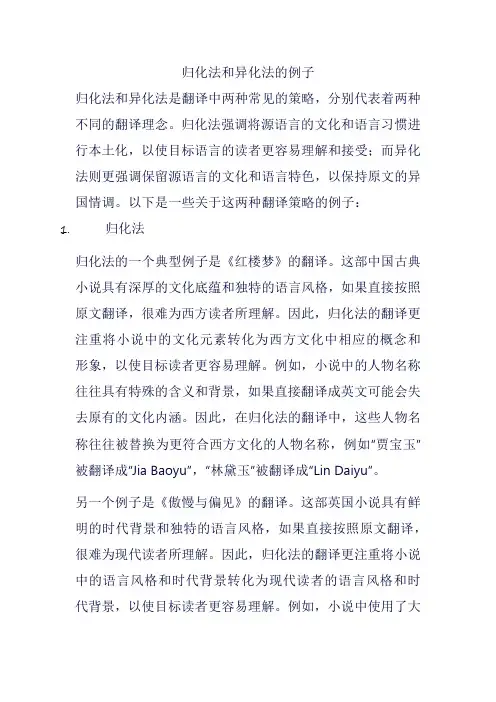
归化法和异化法的例子归化法和异化法是翻译中两种常见的策略,分别代表着两种不同的翻译理念。
归化法强调将源语言的文化和语言习惯进行本土化,以使目标语言的读者更容易理解和接受;而异化法则更强调保留源语言的文化和语言特色,以保持原文的异国情调。
以下是一些关于这两种翻译策略的例子:1.归化法归化法的一个典型例子是《红楼梦》的翻译。
这部中国古典小说具有深厚的文化底蕴和独特的语言风格,如果直接按照原文翻译,很难为西方读者所理解。
因此,归化法的翻译更注重将小说中的文化元素转化为西方文化中相应的概念和形象,以使目标读者更容易理解。
例如,小说中的人物名称往往具有特殊的含义和背景,如果直接翻译成英文可能会失去原有的文化内涵。
因此,在归化法的翻译中,这些人物名称往往被替换为更符合西方文化的人物名称,例如“贾宝玉”被翻译成“Jia Baoyu”,“林黛玉”被翻译成“Lin Daiyu”。
另一个例子是《傲慢与偏见》的翻译。
这部英国小说具有鲜明的时代背景和独特的语言风格,如果直接按照原文翻译,很难为现代读者所理解。
因此,归化法的翻译更注重将小说中的语言风格和时代背景转化为现代读者的语言风格和时代背景,以使目标读者更容易理解。
例如,小说中使用了大量的古英语和诗歌语言,如果直接翻译成现代英语可能会失去原有的韵味。
因此,在归化法的翻译中,这些古英语和诗歌语言往往被替换为更符合现代英语的语言风格,例如“To be, or not to be, that is the question”被翻译成“生存还是毁灭,这是个问题”。
1.异化法异化法的一个典型例子是《百年孤独》的翻译。
这部拉丁美洲小说具有浓厚的魔幻现实主义色彩和独特的语言风格,如果采用归化法的翻译方式,可能会失去原有的特色和韵味。
因此,异化法的翻译更注重保留原文的语言特色和文化元素,以保持原文的异国情调。
例如,小说中使用了大量的比喻和象征手法,如果直接按照原文翻译可能会让读者感到难以理解。
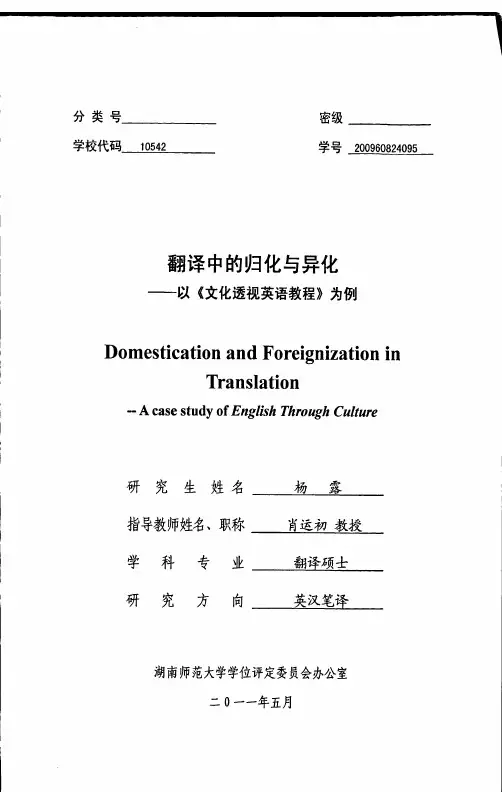
分类号学校代码!鳗鲤密级学号-20-**********翻译中的归化与异化——以《文化透视英语教程》为例DomesticationandForeignizationinrnllranslatlon-·--AcasestudyofEnglishThroughCulture指导教师姓名、职称直鎏塑塾撞湖南师范大学学位评定委员会办公室二0一一年五月’一一一DomesticationandF0relgnlZatlonln,-nlranSIatlon--·-AcasestudyofEnglishThroughCultureA砀esisSubmittedtoForeignStudiesCollegeOfHunanNormalUniversityInPartialFulfillmentoftheRequirementsForTheDegreeofMasterofTranslationandInterpretingByYangLuUndertheSupervisionofProfessorXiaoYunchuChangsha,HunanMay,2011摘要语言是文化的载体,而翻译将两种语言相互转换,传递文化信息,与文化密不可分。
作为文化传递的桥梁,译文既要能被目的语读者接受,又要能传递源语文化。
这种文化的转化引起了归化与异化之争。
在跨文化翻译中,归化与异化各有长短,翻译时应慎重考虑。
归化翻译强调译者应该打破文化间的障碍,避免文化冲突,使译文能被读者接受。
异化翻译强调译文要重现源语语言文化,为读者呈现原汁原味的异域风情和语言风格。
本文主要从三个部分来阐述归化与异化的发展问题:第一部分主要介绍归化和异化问题的由来以及两者的内涵;第二部分主要论述归化和异化在使用时是如何对立统一的;第三部分从翻译实践出发(以英译汉为主),举例说明了归化和异化的具体应用方法;最后得出结论:在跨文化翻译中,归化和异化不是完全对立的,而是相辅相成,相互融合的。
浅析归化和异化策略在文学翻译中的运用-以《挪威的森林》汉译本为例摘要:文学作品是一个国家文化力量的重要载体,文学翻译也对世界各国的交流起到了重要的促进作用。
在文学翻译中,归化和异化是最常被用到两种翻译策略,本文主要是以村上春树的代表作《挪威的森林》汉译本(林少华、赖明珠译本)中的实例为基础,结合笔者自身的翻译实践和知识进行分析,探讨译者该如何恰当地在文学翻译中运用归化和异化策略。
关键词:归化;异化;《挪威的森林》引言随着世界经济全球化,国家间的文化交流也日益紧密,文学作品作为国家文化的载体,对传播本国文化起着重要作用。
由此可见,文学翻译的重要性不言自明。
进行文学翻译就要运用翻译策略,归化和异化作为最常使用到的两种翻译策略,在文学翻译过程中扮演着重要的角色。
1.《挪威的森林》及译者介绍《挪威的森林》是村上春树最著名的小说之一,小说以纪实的手法和诗意的语言,注重表现少男少女在复杂的现代生活中对于纯真爱情和个性的双重追求,超出了一般爱情描写的俗套,而具有更为深刻的人生意义。
林少华,国内著名的翻译家,尤以翻译日本作家村上春树的作品而为大众熟悉。
从1989年翻译《挪威的森林》开始,仅译村上文字已达20年之久。
他总共翻译了村上38部作品,是中国翻译村上作品最多、也是最受欢迎的作家之一。
赖明珠,中国台湾翻译家,日本小说家村上春树的著名翻译者,也是引介村上春树进入台湾出版界的早期推手。
在1989年时,村上春树风潮使得赖明珠开始专心翻译村上的大量长篇小说作品。
直到2001年时,已经翻译了15本,总销量超过100万册。
1.归化与异化归化与异化概念的提出:1995年,美国翻译理论家劳伦斯·韦努蒂的《译者的隐身》问世,里面使用了一对关键术语—domesticating translation & foreignizing translation,中文译作“归化”和“异化”。
归化,是指在翻译中采用透明、流畅的风格,最大限度地淡化原的陌生感的翻译策略。
异化和归化的简单例子异化和归化是翻译过程中的两个重要概念,它们指的是如何在不同语言之间进行适当的转化。
在翻译过程中,有些部分可能需要尽可能地保持原有的风格和意义,即归化;有些部分则需要基于目标语言,并根据受众的需求进行适当的调整,即异化。
下面是一个简单的例子来说明异化和归化的区别。
假设我们需要翻译英文中的一句子:“I’m over the moon”。
这句话意思是“我非常高兴”。
如果我们选择归化翻译,那么我们可以把这句话直接翻译为“我非常高兴”。
这样可以保留原始句子的内涵和文化感受,同时也能够让目标读者更容易理解。
但是,如果我们选择异化翻译,那么根据目标语言的语言背景和文化习惯,我们可能会选择翻译成以下几种不同的方式。
如果翻译成汉语,我们可能会选择说“我心花怒放”,这是汉语中的一个比较传统的说法,用来表达开心和高兴。
如果翻译成法语,我们可能会选择说“je suis au 某anges”,这是法语中的一个常见短语,也用来表达高兴的情感。
如果翻译成西班牙语,我们可能会选择说“estar en la gloria”,这是西班牙语中另一个常用的短语,用来表达高兴和满足感。
从上面的例子中可以看出,异化和归化的翻译方式都有其优缺点。
归化翻译可以更准确地传达原始文本的内涵和情感。
但是,这种方式可能会在目标语言中感觉不够自然或不符合当地的语言和文化习惯。
异化翻译虽然可以更好地适应目标语言和受众的需求,但这样可能会导致一些原始文本的信息丢失或被曲解。
因此,在实际翻译过程中,应该根据具体情况和情感倾向,选择恰当的翻译方式。
在保留原始文本的同时,也要尽可能地适应目标语言和受众的需求,以提高翻译质量和可读性。
翻译中的异化与归化1813年,德国古典语言学家、翻译理论家施莱尔马赫在《论翻译的方法》中提出:翻译的途径“只有两种:一种是尽可能让作者安居不动,而引导读者去接近作者;另一种是尽可能让读者安居不动,而引导作者去接近读者。
”在这里,施氏只是描述了他所说的两种方法,并未授之以什么名称。
1995年,美国翻译理论家劳伦斯·韦努蒂在其The Translator's Invisibility一书中,将第一种方法称作“异化法”(foreignizing method),将第二种方法称作“归化法”(domesticating method)。
(Venuti,1995:20)概括而言,异化法要求译者向作者靠拢,采取相应于作者所使用的源语表达方式,来传达原文的内容;而归化法则要求译者向目的语读者靠拢,采取目的语读者所习惯的目的语表达方式,来传达原文的内容。
从这个界定来看,异化大致相当于直译,归化大致相当于意译,但异化、归化似乎更加原则化。
异化(foreignizing)和归化(domesticating)作为两种主要的翻译方法历来是翻译界争论的焦点之一。
异化是要保存原语的异国情调,就是所谓“洋气”;归化则是用译语文化中惯用的表达方式来转换原语。
一、一方面,世界范围内的人类的经历相似性造就了文化的可译性。
就这点来讲,奈达(Nida)曾讲过“所有的人类都要吃饭、工作、睡觉和生育,他们制造如家俱、工具及车辆等器物。
他们还组成家庭、家族、内部集团和外部集团、国家以及国家间的组织。
他们对于宇宙、价值、宗教和超自然力有着意识上的相似性。
事实上,世界上不同人群的相同之处远远超过相异之处。
”正是由于不同民族文化的相似性,才使得不同文化的人民可以相互理解,使翻译成为可能。
奈达因此指出:“语言学家和人类学家发现使人类联系在一起的因素远远多于使之相疏离的因素,这是产生交流的基础。
”许多一种文化中特有的表达,都可以在另一文化中找到几乎同样的表达,成为文化可译性的最好佐证。
异化翻译与归化翻译异化翻译法(或异化法) (foreignizing translation or minoritizing translation) 和归化翻译法(或归化法) ( domesticating translation or domestication) 是美国翻译理论家Lawrence Venuti (1995)创造出来用来描述翻译策略的两个术语。
异化翻译法是故意使译文冲破目的语的常规,保留原文中的异国情调。
Venuti 把异化翻译法归因于19 世纪德国哲学家Schleiermacher 的翻译论说“译者尽量不惊动原作者,让读者向他靠近”( Schleiermacher , 1838P1963 : 47 , 1838P1977 : 74 ;V enuti ,1995 :19) 。
Schleiermacher 本人是赞同采用异化法的。
Venuti (1995 :20) 指出,在盲目自大地使用单语并把归化翻译法作为标准的文化社会(例如英美社会) 中应提倡异化翻译法。
在这种情况下采用异化法是一种对当时的社会状况进行文化干预的策略,因为这是对主导文化心理的一种挑战。
主导文化心理总是尽力压制译文中的异国情调(或“异物”) 。
Venuti 把异化翻译描述成一种“背离民族的压力”(1995 :20) ,其作用是“把外国文本中的语言文化差异注入目的语之中,把读者送到国外去”(1995 :20) 。
具体来说,异化翻译法包括以下特点: (1)不完全遵循目的语语言与语篇规范; (2) 在适当的时候选择不通顺、艰涩难懂的文体; (3) 有意保留源语中的实观材料或采用目的语中的古词语; (4) 目的是为目的语读者提供一次“前所未有的阅读经验”(1995 : 20) 。
不过,Venuti 也承认,译文是由“本土的文化材料”组成的,异化翻译(像归化翻译那样) 只能是翻译过程中的一种策略,所不同的是,采用异化法的译者一般都态度鲜明,而不是隐隐匿匿(1995 :34) 。
1. spring up like mushrooms 雨后春笋2. every dog has his day 凡人皆有得意日3. to keep one’s head above water 奋力图存4.过着牛马不如的日子To live a dog’s life5.穷的像叫花子as poor as church mouse1. Good to the last drop.滴滴香浓,意犹未尽。
(麦斯威尔咖啡)2. The taste is great. 味道好极了。
(雀巢咖啡)3.You name it, weve got it! 一应俱全(美国某超级市场)4.宾至如归。
Guests Feel at home. (某一酒店广告语)5.城市,让生活更美丽。
Better City, Better life. (上海申办2010年世界博览会)6. 要想体力好,常饮健力宝A Jian Libao a day keeps the doctor away7. lucky dog只能译为“幸运儿”8. Kill two birds with one stone 译为“一石二鸟”豆腐西施Beancurd queen 归化红楼梦A Dream of Red Mansions" 归化财神爷the God of Wealth 归化拆了东墙补西墙:To rob Peter to pay Paul1 to take French leave. 不辞而别2 to seek a hare in a hen’s nest. 缘木求鱼3 to have an old head on young shoulder 少年老成4 Justice has long arms 天网恢恢,疏而不漏5 You can’t teach an old dog. 年逾花甲不堪教6 Rome was not built in a day.冰冻三尺非一日之寒7 He that lives with cripples learns to limp.近朱者赤,近墨者黑8 Everybody’s business is nobody’s business. 三个和尚没水喝1.talk horse 吹牛2.as stupid as a goose 蠢得像猪3.as a stone‘s throw 一箭之遥4.new booms sweep clean 新官上任三把火5.When in Rome, do as the Romans do.入国问禁,入乡随俗6.Self do, self have自作自受1.An hour in the morning is worth two in the evening.译为“一日之计在于晨。
翻译作业10 Nov 15
一、请按归化法(Domestication)翻译下列习语。
Kill two birds with one stone
a wolf in sheep’s clothing
strike while the iron is hot.
go through fire and water
add fuel to the flames / pour oil on the flames
spring up like mushrooms
every dog has his day
keep one’s head above water
live a dog’s life
as poor as a church mouse
a lucky dog
an ass in a lion’s skin
a wolf in sheep’s clothing
Love me, love my dog.
a lion in the way
lick one’s boots
as timid as a hare
at a stone’s throw
as stupid as a goose
wet like a drown rat
as dumb as an oyster
lead a dog’s life
talk horse
One boy is a boy, two boys half a boy, and three boys nobody.
Man proposes, God disposes.
Cry up wine and sell vinegar (cry up, to praise; extol: to cry up one's profession) Once bitten, twice shy.
An hour in the morning is worth two in the evening.
New booms sweep clean.
take French leave
seek a hare in a hen’s nest
have an old head on young shoulder
Justice has long arms
You can’t teach an old dog
Rome was not built in a day.
He that lives with cripples learns to limp.
Everybody’s business is nobody’s business.
The more you get, the more you want.
二、请按异化法(foreignization)翻译下列习语。
Kill two birds with one stone
a wolf in sheep’s clothing
All roads lead to Rome.
an eye for an eye, a tooth for a tooth
a trump card
paper tiger
The Open-door Policy
a castle in the air
crocodile tears
an olive branch
the ivory tower
armed to the teeth
sour grapes
show one’s cards
a castle in the air
Better late than never.
A rolling stone gathers no moss.
Blood is thicker than water.
Misfortunes never come singly.
三、英译汉。
I took the news with a grain of salt.
Unless you’ve got an ace up your sleeve, we are dished.
He went through fire and flood to save his mother.
You have a lucky star above you.
She is now between the devil and the deep sea on this matter.
He is reaping what has sown.
She is an easy-going woman. She always throws her cares to the winds.
That fellow is always fair without, but foul within.
That little girl has a ready tongue.
The light-fingered gentry frequented these shops.
Notes
take sth with a pinch of salt think that sth is not likely to be true; not wholly believe sth 认为某事物不大可能属实; 对某事物半信半疑.
(have) an ace up one's sleeve; US (have) an ace in the hole (infml 口) (have) sth effective kept secretly in reserve 暗中保留的王牌
dish
/ dɪʃ; dɪʃ/ v
[Tn] (Brit infml 口) ruin (sb's hopes or chances); prevent (sb) from succeeding 使(某人的希望)破灭; 破坏(某人的机会); 使(某人)不能成功: The scandal dished his hopes of being elected. 这丑闻使他当选的希望破灭了. * dish one's opponents 击败对手.。